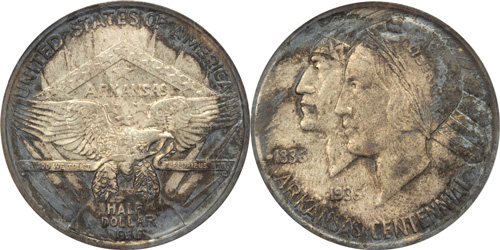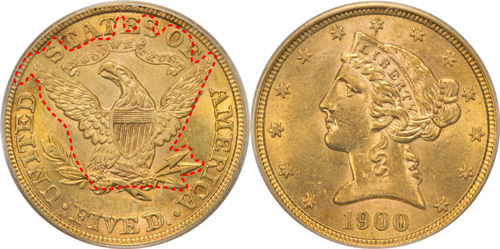- 06/26/2019
- Lou Roten
- Summer 2019
Original Coins are Endangered Specie, Part 2
DIP DAMAGE
I wanted to include the following in the previous newsletter, but time and space did not permit. The following is a more dramatic example of what lies in the future of an over dipped coin that has not been neutralized properly. The chemistry continues in the holder. It is very possible to differentiate a dipped silver coin from one that has not been dipped, particularly one that has been over dipped. The surface lacks the life of the original surface, which may have toned a bit and may not be blast white. However, what is difficult with a coin recently dipped is to determine if any of the dipping solution remains.
Here is an Arkansas Commemorative in an old PCGS green holder graded MS-65 that once was a brilliant (dipped) white. For the 20 odd years the coin has been in its holder, the chemicals used on the coin have done their dirty work, creating a blackened ugly example. A coin in the holder is protected from the environment, but the holder cannot do anything to protect the coin from the nasty stuff that remains at first unseen on the surface of the coin. The coin was not properly neutralized; it seems to me that the dipping residue remains more around the edge of the coin where most of the lettering and numerals are located, the more difficult areas from which to completely remove the dipping solution.

PUTTY on Gold
A common method used to hide unsightly marks on a gold coin to enhance the possible assigned grade is to use model putty to fill those marks. This practice is another example of a process that can continue to work in the holder: here is a 1900 $5 Liberty old green label PCGS AU58 - this coin was puttied years ago then submitted to PCGS. The putty is used to obscure surface flaws and when freshly applied can be very difficult to see, as had to be the case over 20 years ago when this coin was graded. Over time the putty dries out and becomes a milky film on the coin. The film is very evident on the eagle of the reverse, noted by the red dotted line. I think the obverse shows some milky appearance in the word Liberty and around the ear and mouth as well. Should the coin be restored, removing the foreign material, chances are the grade will drop one or two points. A puttied surface is difficult to see at first, but once seen several times becomes more obvious. Moving a coin under a good light will usually expose a puttied surface. The temptation of the old green label does not help, indicating a properly, or perhaps more conservatively graded coin from the 1990’s, 20 years or more before today. Unwanted chemicals will continue to do their mischief in the holder.
The coin really needs to be scrutinized in hand. Images can be deceptive. In other words, a light area on the image of a gold coin does not mean the surface has been puttied. The coin needs to be examined to be certain.

Here is a 1901 $20 Liberty Double Eagle, PCGS MS64+ CAC. The entire coin has a bright appearance, but there is no putty on the surfaces. The coin itself has much more eye appeal than the image shows.

The goal of RCNH is to provide problem free coins, avoiding coins that have been worked on, dipped, puttied, tooled, etc. Our inventory is small compared to many dealers because of the difficulty finding coins that are problem free with original surfaces and, importantly, at a right and reasonable price. CAC is an important factor in RCNH’s choice of coins to include in its inventory. RCNH coins sometimes, but not always, may cost a bit more, a slightly higher price reflecting the time and effort, as well as scarcity of availability, involved in finding good coins. I encourage want lists, with the understanding that it may take some time to locate the right coins in the right grades. A specific coin date/mint can always be found, but there are darn few that have not had their appearance “improved”. It takes time to find the right coin at a competitive price. We appreciate and thank our clients who have the trust and patience to work with us on their want lists.
Lou Roten - adjunct instructor retired - mathematics / physics, Franklin Pierce University; environmental scientist; fiddler; life-long interest in collecting coins and stamps with some interruptions; very interested in the evolution of the coin making process.